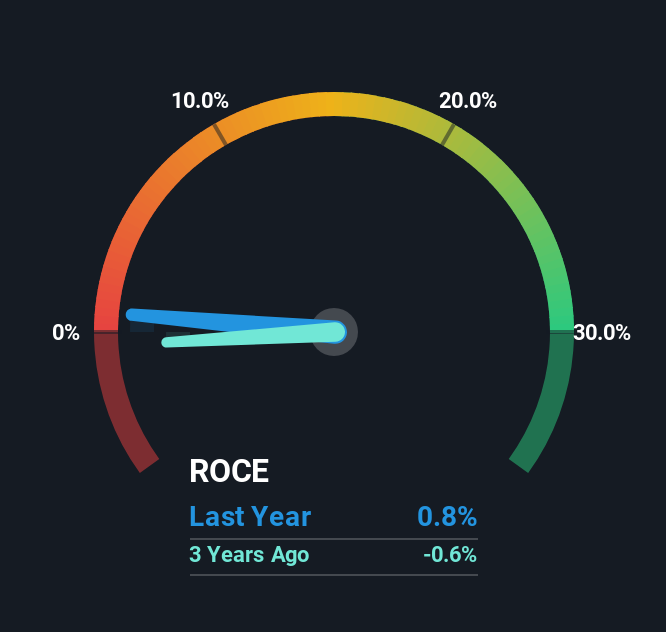Bajaj Hindusthan Sugar (NSE:BAJAJHIND) Is Finding It Tricky To Allocate Its Capital
Ignoring the stock price of a company, what are the underlying trends that tell us a business is past the growth phase? Businesses in decline often have two underlying trends, firstly, a declining return on capital employed (ROCE) and a declining base of capital employed. This indicates to us that the business is not only shrinking the size of its net assets, but its returns are falling as well. In light of that, from a first glance at Bajaj Hindusthan Sugar (NSE:BAJAJHIND), we've spotted some signs that it could be struggling, so let's investigate.
Return On Capital Employed (ROCE): What Is It?
For those that aren't sure what ROCE is, it measures the amount of pre-tax profits a company can generate from the capital employed in its business. Analysts use this formula to calculate it for Bajaj Hindusthan Sugar:
Return on Capital Employed = Earnings Before Interest and Tax (EBIT) ÷ (Total Assets - Current Liabilities)
0.0082 = ₹742m ÷ (₹153b - ₹62b) (Based on the trailing twelve months to March 2025).
Therefore, Bajaj Hindusthan Sugar has an ROCE of 0.8%. Ultimately, that's a low return and it under-performs the Food industry average of 12%.
Check out our latest analysis for Bajaj Hindusthan Sugar

While the past is not representative of the future, it can be helpful to know how a company has performed historically, which is why we have this chart above. If you want to delve into the historical earnings , check out these free graphs detailing revenue and cash flow performance of Bajaj Hindusthan Sugar.
What Can We Tell From Bajaj Hindusthan Sugar's ROCE Trend?
In terms of Bajaj Hindusthan Sugar's historical ROCE movements, the trend doesn't inspire confidence. To be more specific, the ROCE was 2.8% five years ago, but since then it has dropped noticeably. On top of that, it's worth noting that the amount of capital employed within the business has remained relatively steady. Since returns are falling and the business has the same amount of assets employed, this can suggest it's a mature business that hasn't had much growth in the last five years. So because these trends aren't typically conducive to creating a multi-bagger, we wouldn't hold our breath on Bajaj Hindusthan Sugar becoming one if things continue as they have.
On a separate but related note, it's important to know that Bajaj Hindusthan Sugar has a current liabilities to total assets ratio of 40%, which we'd consider pretty high. This effectively means that suppliers (or short-term creditors) are funding a large portion of the business, so just be aware that this can introduce some elements of risk. Ideally we'd like to see this reduce as that would mean fewer obligations bearing risks.
In Conclusion...
All in all, the lower returns from the same amount of capital employed aren't exactly signs of a compounding machine. The market must be rosy on the stock's future because even though the underlying trends aren't too encouraging, the stock has soared 276%. In any case, the current underlying trends don't bode well for long term performance so unless they reverse, we'd start looking elsewhere.
If you're still interested in Bajaj Hindusthan Sugar it's worth checking out our FREE intrinsic value approximation for BAJAJHIND to see if it's trading at an attractive price in other respects.
While Bajaj Hindusthan Sugar may not currently earn the highest returns, we've compiled a list of companies that currently earn more than 25% return on equity. Check out this free list here.
Valuation is complex, but we're here to simplify it.
Discover if Bajaj Hindusthan Sugar might be undervalued or overvalued with our detailed analysis, featuring fair value estimates, potential risks, dividends, insider trades, and its financial condition.
Access Free AnalysisHave feedback on this article? Concerned about the content? Get in touch with us directly. Alternatively, email editorial-team (at) simplywallst.com.
This article by Simply Wall St is general in nature. We provide commentary based on historical data and analyst forecasts only using an unbiased methodology and our articles are not intended to be financial advice. It does not constitute a recommendation to buy or sell any stock, and does not take account of your objectives, or your financial situation. We aim to bring you long-term focused analysis driven by fundamental data. Note that our analysis may not factor in the latest price-sensitive company announcements or qualitative material. Simply Wall St has no position in any stocks mentioned.
About NSEI:BAJAJHIND
Bajaj Hindusthan Sugar
Engages in the manufacture and sale of sugar and alcohol in India.
Slightly overvalued with worrying balance sheet.
Market Insights
Community Narratives



